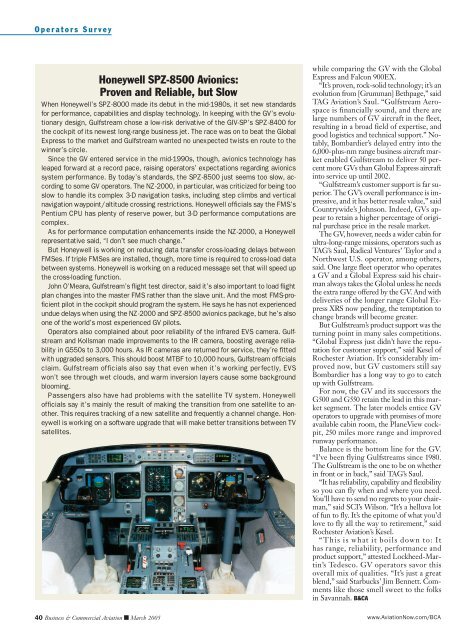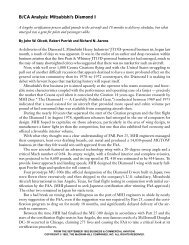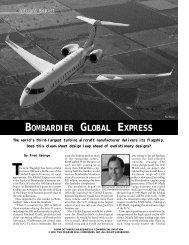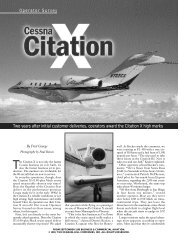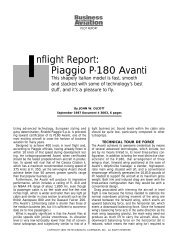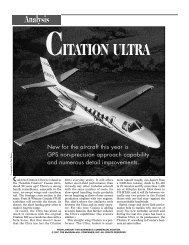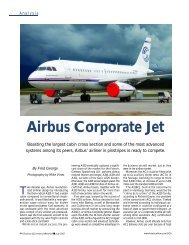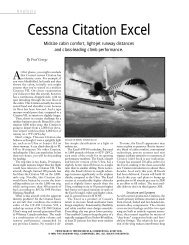Gulfstream V Ops Survey
Gulfstream V Ops Survey
Gulfstream V Ops Survey
Create successful ePaper yourself
Turn your PDF publications into a flip-book with our unique Google optimized e-Paper software.
Operators <strong>Survey</strong>Honeywell SPZ-8500 Avionics:Proven and Reliable, but SlowWhen Honeywell’s SPZ-8000 made its debut in the mid-1980s, it set new standardsfor performance, capabilities and display technology. In keeping with the GV’s evolutionarydesign, <strong>Gulfstream</strong> chose a low-risk derivative of the GIV-SP’s SPZ-8400 forthe cockpit of its newest long-range business jet. The race was on to beat the GlobalExpress to the market and <strong>Gulfstream</strong> wanted no unexpected twists en route to thewinner’s circle.Since the GV entered service in the mid-1990s, though, avionics technology hasleaped forward at a record pace, raising operators’ expectations regarding avionicssystem performance. By today’s standards, the SPZ-8500 just seems too slow, accordingto some GV operators. The NZ-2000, in particular, was criticized for being tooslow to handle its complex 3-D navigation tasks, including step climbs and verticalnavigation waypoint/altitude crossing restrictions. Honeywell officials say the FMS’sPentium CPU has plenty of reserve power, but 3-D performance computations arecomplex.As for performance computation enhancements inside the NZ-2000, a Honeywellrepresentative said, “I don’t see much change.”But Honeywell is working on reducing data transfer cross-loading delays betweenFMSes. If triple FMSes are installed, though, more time is required to cross-load databetween systems. Honeywell is working on a reduced message set that will speed upthe cross-loading function.John O’Meara, <strong>Gulfstream</strong>’s flight test director, said it’s also important to load flightplan changes into the master FMS rather than the slave unit. And the most FMS-proficientpilot in the cockpit should program the system. He says he has not experiencedundue delays when using the NZ-2000 and SPZ-8500 avionics package, but he’s alsoone of the world’s most experienced GV pilots.Operators also complained about poor reliability of the infrared EVS camera. <strong>Gulfstream</strong>and Kollsman made improvements to the IR camera, boosting average reliabilityin G550s to 3,000 hours. As IR cameras are returned for service, they’re fittedwith upgraded sensors. This should boost MTBF to 10,000 hours, <strong>Gulfstream</strong> officialsclaim. <strong>Gulfstream</strong> officials also say that even when it’s working perfectly, EVSwon’t see through wet clouds, and warm inversion layers cause some backgroundblooming.Passengers also have had problems with the satellite TV system. Honeywellofficials say it’s mainly the result of making the transition from one satellite to another.This requires tracking of a new satellite and frequently a channel change. Honeywellis working on a software upgrade that will make better transitions between TVsatellites.40 Business & Commercial Aviation ■ March 2005while comparing the GV with the GlobalExpress and Falcon 900EX.“It’s proven, rock-solid technology; it’s anevolution from [Grumman] Bethpage,” saidTAG Aviation’s Saul. “<strong>Gulfstream</strong> Aerospaceis financially sound, and there arelarge numbers of GV aircraft in the fleet,resulting in a broad field of expertise, andgood logistics and technical support.” Notably,Bombardier’s delayed entry into the6,000-plus-nm range business aircraft marketenabled <strong>Gulfstream</strong> to deliver 50 percentmore GVs than Global Express aircraftinto service up until 2002.“<strong>Gulfstream</strong>’s customer support is far superior.The GV’s overall performance is impressive,and it has better resale value,” saidCountrywide’s Johnson. Indeed, GVs appearto retain a higher percentage of originalpurchase price in the resale market.The GV, however, needs a wider cabin forultra-long-range missions, operators such asTAG’s Saul, Radical Ventures’ Taylor and aNorthwest U.S. operator, among others,said. One large fleet operator who operatesa GV and a Global Express said his chairmanalways takes the Global unless he needsthe extra range offered by the GV. And withdeliveries of the longer range Global ExpressXRS now pending, the temptation tochange brands will become greater.But <strong>Gulfstream</strong>’s product support was theturning point in many sales competitions.“Global Express just didn’t have the reputationfor customer support,” said Kesel ofRochester Aviation. It’s considerably improvednow, but GV customers still sayBombardier has a long way to go to catchup with <strong>Gulfstream</strong>.For now, the GV and its successors theG500 and G550 retain the lead in this marketsegment. The later models entice GVoperators to upgrade with promises of moreavailable cabin room, the PlaneView cockpit,250 miles more range and improvedrunway performance.Balance is the bottom line for the GV.“I’ve been flying <strong>Gulfstream</strong>s since 1980.The <strong>Gulfstream</strong> is the one to be on whetherin front or in back,” said TAG’s Saul.“It has reliability, capability and flexibilityso you can fly when and where you need.You’ll have to send no regrets to your chairman,”said SCI’s Wilson. “It’s a helluva lotof fun to fly. It’s the epitome of what you’dlove to fly all the way to retirement,” saidRochester Aviation’s Kesel.“This is what it boils down to: Ithas range, reliability, performance andproduct support,” attested Lockheed-Martin’sTedesco. GV operators savor thisoverall mix of qualities. “It’s just a greatblend,” said Starbucks’ Jim Bennett. Commentslike those smell sweet to the folksin Savannah. B&CAwww.AviationNow.com/BCA


